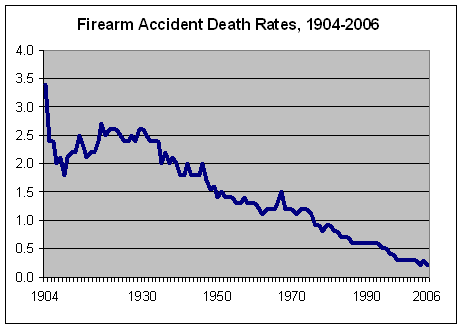mistermack wrote:My contempt for gun lovers goes back a long way, and I've only met one "stable" gun owner in that time.
You need to start hanging out with a better class of people.
I used to house-share a country house, from 1972 to 1977 when I was in my twenties. One of the guys was a farmers son, and he had two shotguns, a 12 bore and a 410 and they were usually lying around in the lounge. (Not loaded). Safety attitudes were different back then.
He was level headed, safety conscious (for the time), and kept the ammo well away from the guns.
I couldn't help but notice the reaction of people visiting, when they saw the guns. The intelligent ones took very little interest in the guns, except as antiques. ( they were beautifully made ). The stupid ones were FASCINATED, and would want to pick them up, point them, pull the trigger, aim at people for FUN, and you could see the dumb fantasies going round their tiny minds. You could tell peoples' intelligence levels just by their reaction to the guns, and it always proved true.
That has more to do with ignorance than anything else. The people who get in the most trouble with guns, including children, are those who are ignorant and uneducated about guns and gun safety.
That militates for better education, not gun bans.
My proposal is that all children be taught gun safety, gun handling, and marksmanship in an age-appropriate manner beginning in the first grade of school, as a mandatory part of the school curriculum. The yearly training would begin with, for example, the Eddie Eagle program directives of "Don't touch, tell an adult" and would be graduated through high school graduation with increasing knowledge and responsibility, including safe gun handling, cleaning, maintenance, and marksmanship training in both pistol and rifle, culminating at high school graduation with the issuing of a concealed carry permit, a Civilian Marksmanship Program rifle and pistol, and formal registration in the Unorganized Militia, which would require annual qualification with the issued service weapons for all students who successfully complete high school, their firearms training, and have not gotten a criminal record. From 18 to 45, they would report annually for inspection of the weapons and marksmanship testing, and if they fail marksmanship training three times consecutively, or have any criminal offenses, their issued arms are taken back. If they successfully complete their term in the Unorganized Militia, at 45, the weapons become their private property by way of thanks from a grateful nation for their service and citizenship.
This would all but eliminate accidental gun deaths and injuries, as demonstrated by the fact that such injuries and deaths are now quite rare compared to a hundred years ago, and thanks primarily to the NRA and its education programs, gun accident rates have dropped more than 90 percent since 1900.
Firearm Safety In America 2009
The number of privately owned guns in the U.S. is at an all-time high, and rises by about 4.5 million per year.1 Below, statistics from 1981 forward are from the National Center for Health Statistics; those prior to 1981 are from the National Safety Council.2 NCHS annual numbers, rates, and trends of common accidents and selected other causes of death, for the U.S., each state, and the District of Columbia, are available on the NRA-ILA website in spreadsheet format.3
The firearm accident death rate is at an all-time annual low, 0.2 per 100,000 population, down 94% since the all-time high in 1904. Since 1930, the annual number of such deaths has decreased 80%, to an all-time low, while the U.S. population has more than doubled and the number of firearms has quintupled. Among children, such deaths have decreased 90% since 1975. Today, the odds are more than a million to one, against a child in the U.S. dying in a firearm accident.

- safety2009.gif (5.01 KiB) Viewed 511 times
safety
Firearms are involved in 0.5% of accidental deaths nationally, compared to motor vehicles (37%), poisoning (22%), falls (17%), suffocation (5%), drowning (2.9%), fires (2.5%), medical mistakes (1.7%), environmental factors (1.3%), and pedal cycles (0.7%). Among children: motor vehicles (41%), suffocation (21%), drowning (15%), fires (8%), pedal cycles (2%), poisoning (2%), falls (1.9%), environmental factors (1.5%), firearms (1.1%) and medical mistakes (1%).
Education decreases accidents. Voluntary training has decreased firearms accidents. NRA firearm safety programs are conducted by more than 62,000 NRA Certified Instructors nationwide. Youngsters learn firearm safety in NRA programs offered through civic groups such as the Boy Scouts, Jaycees, and American Legion, and schools.4 NRA's Eddie Eagle GunSafe program teaches children pre-K through 3rd grade that if they see a gun without supervision, they should "STOP! Don't Touch. Leave The Area. Tell An Adult." Since 1988, Eddie has been used by 26,000 schools, civic groups, and law enforcement agencies to reach more than 22 million children.5
The very worst one I ever saw, who's eyes really lit up when he saw the guns, got several years in jail, years later, for an armed incident at the home of his estranged wife.
Which says absolutely nothing about the character or nature of the rest of the gun owning population. You do realize that your personal experience has absolutely no value whatsoever in determining whether other law-abiding citizens can safely own or carry guns, don't you? It's a single-point data set that only demonstrates your own bias and ignorance and says nothing about anyone else.
The guy who owned the guns, who was NORMALLY safety conscious and careful, had a very lucky escape. He and a friend got totally drunk one night in a night club, got thrown out and roughed up by the bouncers, and went home, got the 12 bore, and went back and threatened the bouncers. They got beat up again. ( They were actually friends of the bouncers when they were sober ).
And the next day, the 12 bore was there, with 410 cartridges, that they had tried to load. Shows how drunk they were.
So I know from experience that even normally safety-conscious people can go mental with a gun, when they get drunk.
And when stupid people do stupid things with guns when they get drunk, they get punished and they lose their right to own guns. That's how it's supposed to work. That's no argument for banning guns for everyone else, as the fact that 260 million guns in more than 115 million households in the US that only a fraction of one percent of all guns privately owned are used in any crime.
More Guns, Less Crime Again
Gun Ownership Rises to All-Time High,
Violent Crime Falls to 35-Year Low
Coinciding with a surge in gun purchases that began shortly before the 2008 elections, violent crime decreased six percent between 2008 and 2009, including an eight percent decrease in murder and a nine percent decrease in robbery.1 Since 1991, when violent crime peaked, it has decreased 43 percent to a 35-year low. Murder has fallen 49 percent to a 45-year low.2 At the same time, the number of guns that Americans own has risen by about 90 million. Predictions by gun control supporters, that increasing the number of guns, particularly handguns and so-called “assault weapons,” would cause crime to increase, have been proven profoundly lacking in clairvoyance.4

More Guns: There are well over 250 million privately-owned firearms in the U.S., including nearly 100 million handguns and tens of millions of “assault weapons”—the types of firearms that gun control supporters have tried the hardest to get banned5—and the number of firearms typically rises about 4 million per year.6 Annual numbers of new AR-15s, the most popular semi-automatic rifle that gun control supporters call an “assault weapon,” are soaring. In 2008, there were more than 337,000 new AR-15s configured for home defense, competition, training, recreational target practice and hunting.7 NRA-supported Instant Check firearm transactions have increased over 10 percent annually since 2006.8
Less Gun Control: Over the last quarter-century, many federal, state and local gun control laws have been eliminated or made less restrictive. The federal “assault weapon” ban, upon which gun control supporters claimed public safety hinged, expired in 2004 and the murder rate has since dropped 10 percent. The federal handgun waiting period, for years the centerpiece of gun control supporters’ agenda, expired in 1998, in favor of the NRA-supported national Instant Check, and the murder rate has since dropped 21 percent. Accordingly, some states have eliminated obsolete waiting periods and purchase permit requirements. There are now 40 Right-to-Carry states, an all-time high, up from 10 in 1987. All states have hunter protection laws, 48 have range protection laws, 48 prohibit local gun laws more restrictive than state law, 44 protect the right to arms in their constitutions, 33 have “castle doctrine” laws protecting the right to use guns in self-defense, and Congress and 33 states prohibit frivolous lawsuits against the firearm industry.9 Studies for Congress, the Congressional Research Service, the Library of Congress, the National Institutes of Justice, the National Academy of Sciences, and the Centers for Disease Control and Prevention have found no evidence that gun control reduces crime.10 The FBI doesn’t list gun control as one of the many factors that determine the type and level of crime from place to place.11
So, your single-point anecdotal experience is useless as a basis for any rational public policy decision by anyone, including yourself.
"Seth is Grandmaster Zen Troll who trains his victims to troll themselves every time they think of him" Robert_S
"All that is required for the triumph of evil is that good men do nothing." Edmund Burke
"Those who support denying anyone the right to keep and bear arms for personal defense are fully complicit in every crime that might have been prevented had the victim been effectively armed." Seth
© 2013/2014/2015/2016 Seth, all rights reserved. No reuse, republication, duplication, or derivative work is authorized.